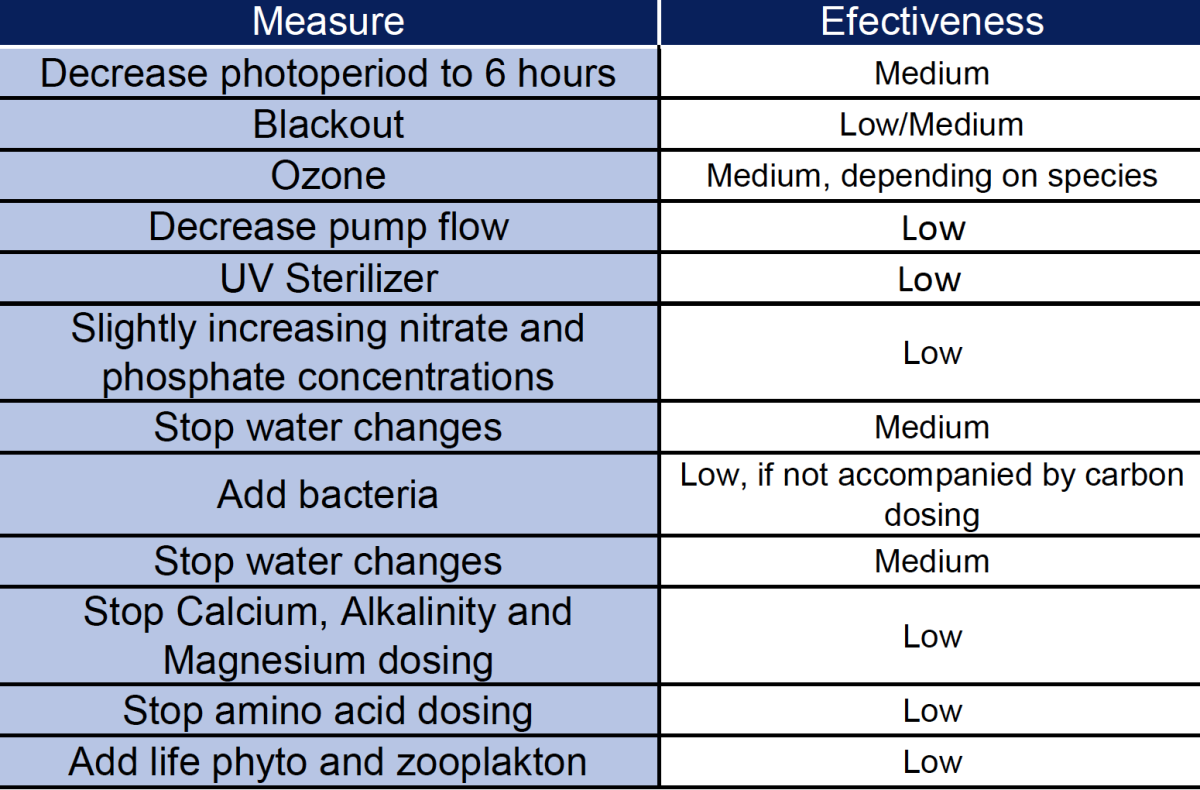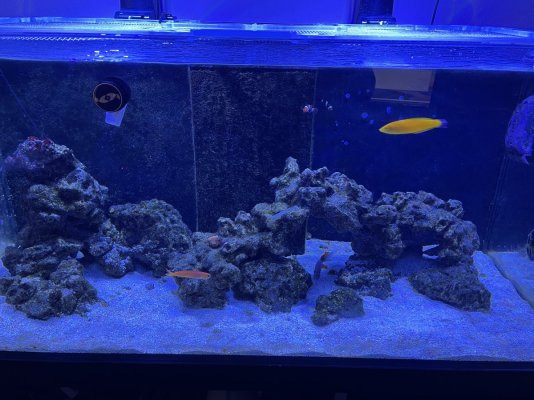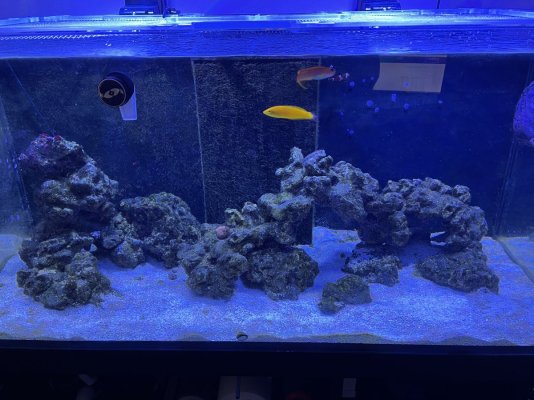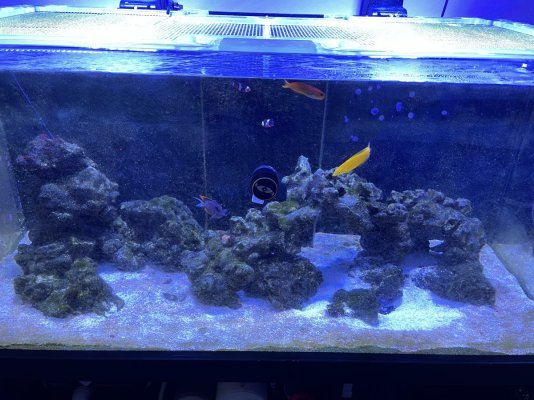Do I need to do an actual blackout, or would just turning the lights off suffice?thank y'all for doing this.
If UV is in place, then a short blackout (<48hr) or two to push the cells into the water can be very helpful. Prorocentrum are more comfortable hanging out where they are, than say ostreopsis.
Navigation
Install the app
How to install the app on iOS
Follow along with the video below to see how to install our site as a web app on your home screen.
Note: This feature may not be available in some browsers.
More options
You are using an out of date browser. It may not display this or other websites correctly.
You should upgrade or use an alternative browser.
You should upgrade or use an alternative browser.
Documenting my fight against Prorocentrum Dinoflagellates
- Thread starter TexanReefer
- Start date
- Tagged users None
as dark as possible. You’re trying to drive the Dinos to search for better growing conditions (ie light), and when they do, the UV zaps ‘em.
I’m saving it for last as I’ve got a bunch of frags growing.
I’m saving it for last as I’ve got a bunch of frags growing.
- Joined
- May 22, 2016
- Messages
- 6,542
- Reaction score
- 10,097
Do I need to do an actual blackout, or would just turning the lights off suffice?
as dark as possible. You’re trying to drive the Dinos to search for better growing conditions (ie light), and when they do, the UV zaps ‘em.
I’m saving it for last as I’ve got a bunch of frags growing.
It might work better if it's darker, but it's also likely that just turning off the lights will cause more cells to take to the water to look for an optimal location.
So it might be a matter of degree. The other thing I'd mention is that this is not the 3 day blackout that's commonly used to knock back algae growth. It can be less dramatic because it's just meant to cause the dinos to seek a better spot.
I'm starting a 36 hour blackout. Covered the sides with a sheet but left most of the top openIt might work better if it's darker, but it's also likely that just turning off the lights will cause more cells to take to the water to look for an optimal location.
So it might be a matter of degree. The other thing I'd mention is that this is not the 3 day blackout that's commonly used to knock back algae growth. It can be less dramatic because it's just meant to cause the dinos to seek a better spot.
A last minute change of plans means I’m away from home until Monday. I think I’ll start a blackout, too. I’ll just turn the apex outlets off once the lights go out this evening.
Might as well do 36 hours, too. Though, i can’t cover the tank at all. it’s not the most scientific — too many other variables — but I’m curious to see if we have different outcomes as a result of the presence of a cover.
Given the prevalance of dino problems, @Bulk Reef Supply should do a multi-tank experiment on dino eradication like they did on starting tanks/biome cycle. A tank with uv, one with pods, one with blackouts, one with bottle bacteria, etc. Figure out a way to control every other variable and a way to consistently measure Dino population across the tanks, and determine efficacy of each method. Then, a common protocol could be developed from the most successful methods.
Might as well do 36 hours, too. Though, i can’t cover the tank at all. it’s not the most scientific — too many other variables — but I’m curious to see if we have different outcomes as a result of the presence of a cover.
Given the prevalance of dino problems, @Bulk Reef Supply should do a multi-tank experiment on dino eradication like they did on starting tanks/biome cycle. A tank with uv, one with pods, one with blackouts, one with bottle bacteria, etc. Figure out a way to control every other variable and a way to consistently measure Dino population across the tanks, and determine efficacy of each method. Then, a common protocol could be developed from the most successful methods.
Last edited:
I’ve seen similar shifts in phosphate, even after removing GFO. I’m guessing it has to do with bacteria/dino/algae uptake but I’m no biologist.
I’m sure they’ll be bottomed out when I get home on Monday. Had I known I was going to be away all weekend in advance. I’d have figured out a daily dose of neophos so I could run it through my open doser head.
oh well.
I’m sure they’ll be bottomed out when I get home on Monday. Had I known I was going to be away all weekend in advance. I’d have figured out a daily dose of neophos so I could run it through my open doser head.
oh well.
Don't know what happened, but I dosed 4ppm Nitrates and .01 ppm Phosphates....did a retest after 6 hours. 15 Nitrate...and .04 phosphate. Maybe my tests earlier were an error, but i'm still fine with those numbers
A few things:
1. I forgot to reset my ATO sensor before I left on Friday resulting in the return sucking air. Fixed it via Apex on Saturday night, but given the Trident controlled dosing keeping Alk consistent, it meant I lost 0.2 dKh when I refilled the sump.
2. 36 hour lights-out helped a bit. I'm seeing more cyano and less dino on the sand. Still have dino on the rocks.
3. I dosed Dino-x last night and awoke to rocks that weren't furry. In fact, I don't really see dinos anywhere. Just some cyano on the sand. New tank, cyano isn't entirely unexpected.
I'll continue to monitor, and I don't plan on dosing dino-x long-term due to coral concerns, but it definitely seems to have thrown a hefty punch. I just added my weekly dose of AF life source and I plan on using @SunnyX's calcium carbonate + bacteria mixture to hit the cyano later today.
I also started using a 1-10mL autopipette for testing, so there should be more precision on my test results going forward.
Current nutrients:
PO4: 0.03
NO3: 13.5
1. I forgot to reset my ATO sensor before I left on Friday resulting in the return sucking air. Fixed it via Apex on Saturday night, but given the Trident controlled dosing keeping Alk consistent, it meant I lost 0.2 dKh when I refilled the sump.
2. 36 hour lights-out helped a bit. I'm seeing more cyano and less dino on the sand. Still have dino on the rocks.
3. I dosed Dino-x last night and awoke to rocks that weren't furry. In fact, I don't really see dinos anywhere. Just some cyano on the sand. New tank, cyano isn't entirely unexpected.
I'll continue to monitor, and I don't plan on dosing dino-x long-term due to coral concerns, but it definitely seems to have thrown a hefty punch. I just added my weekly dose of AF life source and I plan on using @SunnyX's calcium carbonate + bacteria mixture to hit the cyano later today.
I also started using a 1-10mL autopipette for testing, so there should be more precision on my test results going forward.
Current nutrients:
PO4: 0.03
NO3: 13.5
Well, I was tagged here so I guess that I will chime in with my experience and what worked for me.
Having dealt with Dino's in the past, and a heavy infestation, I learned that they do not like high Ph or high temperatures. Particularly, a higher temperature.
Combined with the standard tactics of combating them as you have listed, raising the tank temperature to 82-83 degrees for a few days did the trick for me. Apparently, Dino's have a hard time reproducing in a higher than normal temperature. Care must be taken to safeguard your inhabitants but if all else has failed try increasing the temperature.
As @gbru316 mentioned, the Coral Snow mixture may help to bind up some of the free floating Dino's. In the past I have used the Coral Snow along with a canister filter running a very small micron filter(1) to help grab everything that was being bonded up to the snow.
-Sonny
Having dealt with Dino's in the past, and a heavy infestation, I learned that they do not like high Ph or high temperatures. Particularly, a higher temperature.
Combined with the standard tactics of combating them as you have listed, raising the tank temperature to 82-83 degrees for a few days did the trick for me. Apparently, Dino's have a hard time reproducing in a higher than normal temperature. Care must be taken to safeguard your inhabitants but if all else has failed try increasing the temperature.
As @gbru316 mentioned, the Coral Snow mixture may help to bind up some of the free floating Dino's. In the past I have used the Coral Snow along with a canister filter running a very small micron filter(1) to help grab everything that was being bonded up to the snow.
-Sonny
Last edited:
Well, I was tagged here so I guess that I will chime in with my experience and what worked for me.
Having dealt with Dino's in the past, and a heavy infestation, I learned that they do not like high Ph or high temperatures. Particularly, a higher temperature.
Combined with the standard tactics of combating them as you have listed, raising the tank temperature to 82-83 degrees for a few days did the trick for me. Apparently, Dino's have a hard time reproducing in a higher than normal temperature. Care must be taken to safeguard you're inhabitants but if all else has failed try increasing the temperature.
As @gbru316 mentioned, the Coral Snow mixture may help to bind up some of the free floating Dino's. In the past I have used the Coral Snow along with a canister filter running a very small micron filter(1) to help grab everything that was being bonded up to the snow.
-Sonny
I only tagged you because I mentioned your coral snow, but your input is much appreciated!
I haven't considered raising temp yet. I also have a spare BRS media reactor that I could drop a 1 micron filter in without much hassle. Will keep those suggestions in mind
Happy to report that 2 days after dosing dino x (following manufacturer guidelines verbatim), I still have no visible dinos.
This combination of treatments (UV + Dino X + elimination of any vitamin/amino + 36 hour blackout + pods) seems to be working. While I did implement these concurrently, the biggest change was observed directly after dosing Dino X. Given that, I'm confident in saying that it's at least partially effective against prorocentrum.
Earlier this evening, I prepared a few slides and verified that they're still present, albeit in reduced numbers so I treated with a second dose.
Regarding impact on higher order livestock -- I've not noticed any irritation or harm to anything in the tank. In fact, one of my acropora specimens now has much more PE than I've previously observed. That's probably more a result of acclimating to the tank as I've only had it about a month, but I mention it to show that there has been no detrimental impact to the tank as a whole.
Fauna Marin recommends treating until dinos are gone (which they say typically takes 10 treatments). Whether that means invisible to the naked eye, or totally eliminated, I'm not sure. @taricha, what do you think? @Fauna Marin -- what's the goal here? Invisible? Or non-existant?
I'm still planning on implementing ozone and a permanently installed UV sterilizer. Not specifically because of dinos, but because they're other levers I can pull in the futureif when I run into problems.
This combination of treatments (UV + Dino X + elimination of any vitamin/amino + 36 hour blackout + pods) seems to be working. While I did implement these concurrently, the biggest change was observed directly after dosing Dino X. Given that, I'm confident in saying that it's at least partially effective against prorocentrum.
Earlier this evening, I prepared a few slides and verified that they're still present, albeit in reduced numbers so I treated with a second dose.
Regarding impact on higher order livestock -- I've not noticed any irritation or harm to anything in the tank. In fact, one of my acropora specimens now has much more PE than I've previously observed. That's probably more a result of acclimating to the tank as I've only had it about a month, but I mention it to show that there has been no detrimental impact to the tank as a whole.
Fauna Marin recommends treating until dinos are gone (which they say typically takes 10 treatments). Whether that means invisible to the naked eye, or totally eliminated, I'm not sure. @taricha, what do you think? @Fauna Marin -- what's the goal here? Invisible? Or non-existant?
I'm still planning on implementing ozone and a permanently installed UV sterilizer. Not specifically because of dinos, but because they're other levers I can pull in the future
Last edited:
Update July 26th
Ive been continuing to dose nitrate and phosphates to keep it around 10-15 nitrates and .05-.10 phosphates.
I am still running my UV sterilizer.
I started dosing 20 ml of phyto daily
I am also dosing silica. And have the tank at 82-83 degrees.
overall the tank is growing lots of algae on the glass and rocks. A mix of turf and GHA. Sand bed is no longer stringy and it’s basically just a dusting, which under the microscope is a mix of diatoms and Dinos.
I feel confident that with time the Dino’s will be replaced entirely by diatoms which are a much easier nuisance to deal with.
I really appreciate everyone help and advice and I hope this thread helps someone else in the future
Ive been continuing to dose nitrate and phosphates to keep it around 10-15 nitrates and .05-.10 phosphates.
I am still running my UV sterilizer.
I started dosing 20 ml of phyto daily
I am also dosing silica. And have the tank at 82-83 degrees.
overall the tank is growing lots of algae on the glass and rocks. A mix of turf and GHA. Sand bed is no longer stringy and it’s basically just a dusting, which under the microscope is a mix of diatoms and Dinos.
I feel confident that with time the Dino’s will be replaced entirely by diatoms which are a much easier nuisance to deal with.
I really appreciate everyone help and advice and I hope this thread helps someone else in the future
Attachments
sixty_reefer
5000 Club Member
View BadgesArticle Contributor
UK Reef Club Member
Hospitality Award
R2R Research
Have you guys seen this article yet?

 www.reef2reef.com
www.reef2reef.com
Dinoflagelates. A disruptive treatment
THE PROBLEM As is well known, dinoflagellate pests in the reef aquarium are perhaps the worst that we will face during the life of our system. These pests are quite difficult to eradicate because dinoflagellates have a great capacity for...
 www.reef2reef.com
www.reef2reef.com
Have you guys seen this article yet?

Dinoflagelates. A disruptive treatment
THE PROBLEM As is well known, dinoflagellate pests in the reef aquarium are perhaps the worst that we will face during the life of our system. These pests are quite difficult to eradicate because dinoflagellates have a great capacity for...www.reef2reef.com
Yeah, I already carbon dose via AF Pro Bio S and AF -NP Pro. I typically dose Sunny's calcium carbonate slurry with Pro Bio S once a week. Maybe I need to increase carbon additions. The amphidium is nowhere near infestation levels -- but it's noticeable.
I've also got ozone running (started a week ago) and will have full time UV running, dialed in for a slower flow rate.
I suspect my error was pulling the UV out too early. Once I get the permanent UV installed, I'm going to hit the tank with another shot of dino X, start the 3-4x daily tank scrubs again, and go from there.
Similar threads
- Replies
- 1
- Views
- 188
- Replies
- 19
- Views
- 403
- Replies
- 24
- Views
- 823
- Replies
- 3
- Views
- 149
- Replies
- 5
- Views
- 255





















